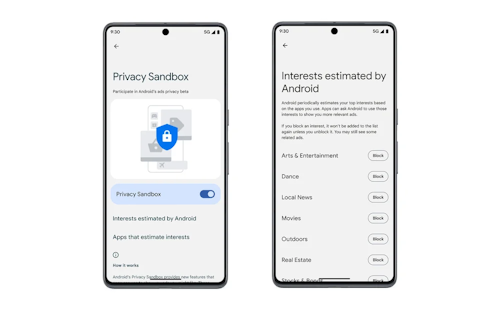From Chrome to Android: A 2024 roadmap for the Privacy Sandbox
January 25, 2024

Chrome’s third-party cookies will be phased out in 2024 – and for some users, as early as the first quarter. Alternative solutions are more in demand than ever – and Google is paving the way with their Privacy Sandbox. To learn about the latest developments and opportunities that the Privacy Sandbox has to offer, onlinemarketing.de spoke to Google, Remerge and AppsFlyer about their collaboration on this initiative. The below article was originally written in German by Niklas Lewanczik.
Privacy Sandbox update: A roadmap for marketing in the privacy-first era
Online marketing will change dramatically in 2024. The deprecation of third-party cookies in Chrome has been in the works for years – and now it’s here. Starting in the first quarter of the new year, scaled testing of new, alternative solutions through the Privacy Sandbox will be begin as cookies are disabled for one percent of Chrome users. Google's Anthony Chavez, VP of the Privacy Sandbox, explains:
“On January 4th, we'll begin testing ‘Tracking Protection’, a new feature which, by default, limits cross-site tracking by limiting websites' access to third-party cookies. This is an important milestone in our Privacy Sandbox initiative, with the aim of phasing out third-party cookies for all users in the second half of 2024; provided we have satisfied the requirements of the UK’s ‘Competition and Markets Authority.”

The Privacy Sandbox is Google's toolbox of advertising solutions. According to Hanne Tuomisto-Inch, Google's Director of Privacy Sandbox Partnerships in the EMEA region, the initiative provides the building blocks for privacy-centric advertising. These tools enable industry players to develop and use contemporary and data protection-friendly advertising solutions. Together with Roy Yanai, Vice President of Product at AppsFlyer, Pan Katsukis, CEO and founder of Remerge, and Lidia Schneck, Strategic Partner Development Manager at Google, we discussed the latest developments around the Privacy Sandbox, as well as the current touchpoints and opportunities for the industry.
The Privacy Sandbox and the deprecation of cookies. What happens next?
According to Tuomisto-Inch, the Privacy Sandbox is ‘a technology where privacy takes precedence’.
This sentiment was evident in the latest Chrome update, which arrived just in time for the browser's 15th birthday – enabling more security and personalization options than ever. With its various data protection features and user-centric initiatives, Google has already surpassed several milestones in 2023 on its journey to a future of cookieless marketing. For example, in March of 2023, the company announced that it was partnering with Fastly to operate an Oblivious HTTP Relay (OHTTP), creating an alternative targeting tool called ‘Protected Audience’ (previously known as FLEDGE).
OHTTP Relay, Fastly explains, provides fast and reliable separation and isolation of an individual’s user data, while forwarding non-identifying requests to the business server. This is intended to protect individual user information while collecting aggregated data. Mozilla also relies on this OHTTP solution for the Firefox browser.
The Protected Audience API is one of the solutions from the Privacy Sandbox that Google is making available to the industry, in order to enable a cookieless future. Other tools of the Sandbox include the Topics API (the successor to FLoC), the Attribution Reporting API, Private State Token API and Related Website Sets API. But how exactly do these solutions help marketers to launch successful, privacy-compliant advertising initiatives in 2024 and beyond?
Testing, testing, testing
As with any other marketing channel, extensive testing is the key to finding long term success in a world without cookies. Google recently created a guide for using the Attribution Reporting API (ARA) and explained how the Google Ads team uses it for measurement of advertising metrics. Harikesh Nair, senior director of data science and ads measurement at Google, explains:
“It’s crucial for ad-tech providers to effectively configure the ARA for their use cases. Google’s ads teams have found that configuring specific ARA settings can lead to notable accuracy improvements. We encourage other ad-tech providers to integrate with the ARA to retrieve the conversion data they need, and process the ARA’s output to help maintain accurate measurement in a post-third-party-cookie world. The ARA is flexible to support various use cases.”
Google made the Privacy Sandbox's Relevance and Measurement APIs available to all Chrome users in September 2023 and expects “a wide range of testing methodologies based on different testing objectives - from individual company testing to broader coordinated testing across multiple organizations.’’ In this blog post, Google’s Chavez explains:
“We look forward to continuing to work with participants across the entire industry as we take these next steps toward eliminating third-party cookies in Chrome to improve online privacy for everyone.”
It’s already been a few months since Google presented the first test results in relation to the Topics API. Their tests reveal that the new data protection-friendly solutions can perform similarly to third-party cookies. In the test, the rate at which users click on an ad, (CTR), was 90 percent of what it currently is with cookies. Dan Taylor, Vice President of Global Ads at Google, explains how performance can be optimized without third-party cookies:
“Our tests show that campaigns can be optimized using AI-supported solutions. For example, campaigns that used 'Optimized Targeting' or the 'Maximize Conversions' bidding strategy achieved even better results, proving that AI-powered optimization solutions will play an important role.”
According to Dan Taylor, results derived from the testing of measurement solutions are likely to vary – but over time, they will give industry players a clearer picture of what is needed to run marketing initiatives in a future without third-party cookies.
The Privacy Sandbox is also being tested for Android
Mobile testing was also made possible for select industry players in February 2023, following the long-awaited beta launch of the Privacy Sandbox for Android. Companies testing these mobile privacy tools include the DSP Remerge and the MMP AppsFlyer.

The Privacy Sandbox for Android is available to AdTech platforms for testing on an increasing number of Android 13 devices. Remerge CEO Pan Katsukis, Roy Yanai, VP of Product at AppsFlyer and Hanne Tuomisto-Inch, Google's Director of Privacy Sandbox Partnerships for EMEA, all agree that advertisers and mobile marketers should ask their providers about current test results and developments in order to stay up to date. Transparent conversation on the topic seems to be more important than ever, with Roy Yanai explaining in a recent interview: “speak to your providers – this is the time to make changes.”
App developers who cooperate with third-party providers for advertising-related services can participate in the Privacy Sandbox tests through their providers. Google has also published a special guide for developers on how to take part in the beta phase. This explains how and why developers should use the Android Extensions SDK with the Privacy Sandbox APIs. In terms of beta testing, the Attribution Reporting API is already available on a significant proportion of Android 13 devices. There are plans to further expand availability for all APIs, in order to help AdTech providers conduct more scaled testing in the coming months.
By running these early tests, DSPs like Remerge and MMPs like AppsFlyer play a crucial role in shaping a future where mobile advertising does not rely on cross-app identifiers.

Emerging potential for the marketing scene
The goal of the Privacy Sandbox for Android is to reassure users that their data is protected. In parallel, Google also wants to provide developers and companies with the tools they need to achieve success in mobile advertising. The company wants to avoid methods such as fingerprinting for user tracking and therefore wants to involve companies in the process of developing privacy-centric solutions. The companies' tests also reveal issues and challenges that don’t exist within cookie-based advertising. Roy Yanai and Pan Katsukis say they are evaluating these gaps and trying to bridge them with suitable solutions. This is the only way marketing can develop in the long term. For some time, users have been demanding more data protection – not only in terms of advertising, but in everyday digital life.
Opportunity reshuffle
The shift toward data privacy also creates new potential for the way in which advertising and performance data will be classified in future. Speaking of this ‘opportunity reshuffle’, Roy Yanai explains:
“After extensive research and collaboration with the teams at Android and Remerge, we are excited about the possibilities that the Protected Audience API will open up for many companies in the remarketing space. Beyond remarketing, the Protected Audience API is a big step forward for the app ecosystem and shows how technology can be used to protect privacy without impacting the user experience.”
Companies have to prepare for changes; the CRM function alone will have to change significantly when using the Privacy Sandbox’s cookieless solutions. Events for performance measurement may need to be redefined – and so will target audiences and targeting parameters. Companies who adapt well, (ideally now), will have the greatest competitive advantage in the long term. This is also why it's so important for all industry participants to get in touch with providers, advertising companies, media, Google, and other players, to keep up with the status quo. Ultimately, it is not advertising itself that will have to change, but rather the technology and the way in which marketing channels are used.
According to Pan Katsukis, the new types of attribution reporting offer big advantages for advertising measurement because they finally bridge the gap between app and web. In the mobile age, this is an opportunity that the marketing industry can look forward to.
Stay tuned – Google and other players like Remerge and AppsFlyer will have more developments to share in early 2024.
Join our newsletter





